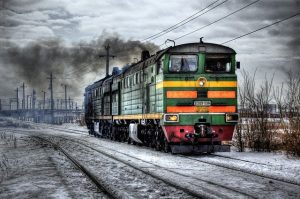According to the US Department of Transportation, the national railway system transports around 4.5m tons of toxic chemicals each year.
There were more toxic chemicals aboard the train that derailed in Ohio on Feb. 3 than originally reported, new data shows. Initially, local authorities were concerned about the presence of vinyl chloride, a highly volatile gas used to manufacture plastic. Thousands of people in East Palestine were evacuated while officials conducted a “controlled release” of the vinyl chloride, sending a toxic cloud of black smoke into the air. Other dangerous chemicals were also emitted during the operation. Among them phosgene, a highly toxic gas that was used as a chemical weapon during World War I, and hydrogen chloride, which, when dissolved in water, forms hydrochloric acid, a strong and highly corrosive acid.
While authorities say there’s no danger to the population, residents in the area are complaining the streams are full of dead fish, and chickens were found dead in their coops. Other people reported seeing foxes dying in the area. Many residents are afraid to use tap water, although authorities claim it is safe.
Experts say the fiery crash in East Palestine should be a wake-up call to the dangers of deadly train derailments. The next one could be “cataclysmic”. The catastrophe in Ohio raises a lot of questions. Who is responsible for the safety of the population and who is liable for damages in a train accident?
Knowledgeable Ohio train accident lawyers say that to establish liability you must first determine the true cause of the crash.
Main causes of train accidents in the US

According to the US Department of Transportation, the national railway system transports around 4.5m tons of toxic chemicals each year. An average of 12,000 rail cars carrying hazardous materials pass through or near urban centers each day. The most common causes of train accidents include:
Human error
Mistakes made by train operators or other personnel, such as misreading signals, failing to follow procedures, or being distracted or fatigued while on the job.
Track and equipment problems
Issues with the tracks themselves, such as broken or missing rails, or equipment failures such as brake malfunctions, coupling problems, or defective parts.
Weather conditions
Heavy rain, snow, or high winds can make tracks slick or cause other hazardous conditions.
Sabotage or intentional acts
Train accidents can also be caused by criminal activity, such as acts of vandalism, terrorism, or sabotage.
Other factors
This refers to design flaws, communication failures, and mismanagement by railway companies or government agencies responsible for overseeing rail transportation.
In many cases, accidents may be caused by a combination of factors rather than a single underlying cause. The investigation into the East Palestine derailment is still ongoing, but it is believed the accident was caused by a broken axle on a train car.
Essential steps when suing a public entity in Ohio
If you or a loved one were recently injured following a train crash, you need to reach out to skilled accident attorneys and have them determine who can be held accountable for damages. In some cases, the train operator or company may be liable for damages, while in other cases, third parties such as manufacturers or maintenance providers may be held responsible.
You need to act fast as special regulations apply if you want to sue a public entity in the US. Here’s what you need to know.
Notice: When suing a public entity, your lawyers will have to send them a notice of claim, usually within a few months of the incident that gave rise to the claim. Depending on their answer, your legal team will decide what to do next. In some cases, it is possible to negotiate a settlement. If they deny responsibility, the only option is to sue them.
Statute of limitations: In Ohio, the time limit for filing a lawsuit is 2 years.
Jurisdiction: Depending on the type of claim, the lawsuit may need to be filed in a specific court or with a specific agency.
Damages: The plaintiff must be able to show that they suffered harm or damages as a result of the public entity’s actions or negligence. If the accident resulted in property damage, make sure to document it properly. If you were injured in any way, see a doctor as soon as possible.
It’s important to note that suing a public entity can be a complex and lengthy process, and you must consult with an experienced attorney who can guide you through the process and help ensure that all requirements are met.
Sources:
1. Ohio catastrophe is ‘wake-up call’ to dangers of deadly train derailments


Join the conversation!